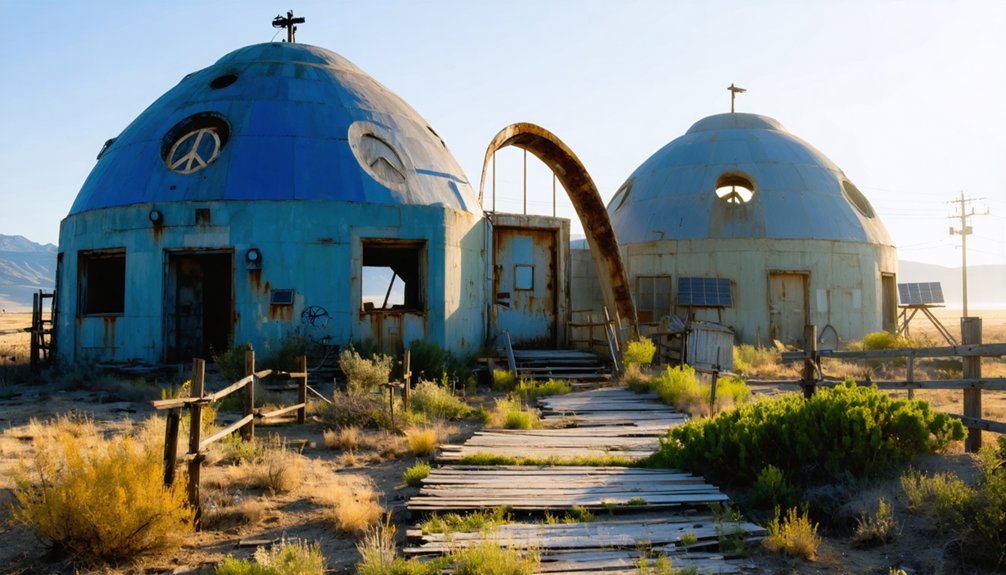America’s failed communal experiments have left fascinating physical remnants you can visit today. From Plymouth Colony‘s early communal system that settlers considered “a kind of slavery,” to the still-standing Shaker villages and Oneida Community Mansion House, these sites reveal the tension between idealistic vision and practical reality. You’ll find preserved structures at Hancock Shaker Village, Harmony Historic District, and the Amana Colonies—each telling stories of utopian dreams that ultimately transformed or collapsed.
Key Takeaways
- Hancock Shaker Village and Harmony Historic District preserve architectural remnants of once-thriving communal settlements as National Historic Landmarks.
- Oneida Community Mansion House stands as physical evidence of a 19th-century commune that peaked at 300 members.
- Plymouth Colony’s transition from communal to private property in 1623 is documented through historical records and archaeological sites.
- Fire destroyed both Brook Farm’s uninsured Phalanstery in 1846 and Upton Sinclair’s Helicon Home Colony in 1907.
- Amana Colonies in Iowa feature seven planned villages that represent one of America’s longest-lasting communal experiments.
Plymouth Colony: From Communal Society to “A Kind of Slavery”

When the Pilgrims established Plymouth Colony in 1620, they didn’t immediately embrace the individualistic principles that would later define American capitalism, but rather implemented a communal property system at the insistence of their financial backers.
You’d find all resources—food, supplies, and harvests—pooled in a common storehouse and distributed equally regardless of individual contribution.
This experiment quickly revealed communal challenges as productivity plummeted. Young men resisted working for others without compensation, creating widespread discontent. The system directly contradicted human nature by ignoring the importance of economic incentives. The population struggled to sustain itself, peaking at only 150 total colonists before declining significantly.
The communal experiment faltered as men rejected uncompensated labor, revealing fundamental flaws in Plymouth’s initial economic design.
Bradford noted colonists felt reduced to “a kind of slavery” under the system. Facing starvation, colony leadership executed a property alteration in 1623, assigning private plots to families based on household size.
The results were dramatic—food production soared, colony prosperity increased, and the social fabric strengthened, providing an early American lesson about incentives and human nature.
Shaker Communities: Economic Success Through Spiritual Principles
Unlike the failed Plymouth experiment in communal living, the Shaker communities that emerged in late 18th and 19th century America achieved remarkable economic success through a unique integration of spiritual principles with practical economic organization.
Their model leveraged Shaker principles of perfection, cleanliness, and frugality to create highly productive enterprises that outperformed conventional operations of their time.
- Religious discipline solved the traditional incentive problem in communal economies
- Scientific agricultural methods yielded superior productivity even on marginal New England lands
- Manufacturing enterprises produced nationally recognized products like furniture and medicinals
- Gender-based labor organization maintained traditional roles while maximizing efficiency
- Commercial networks expanded from local markets to mainstream national demand
This economic resilience wasn’t achieved by abandoning communalism, but by reinforcing it with spiritual discipline and practical specialization, creating a sustainable alternative to capitalism’s individualistic approach. The Shakers’ written covenants established in the 1790s formalized the consecration of property and labor to their society, strengthening their economic foundation. Empirical evidence from census data between 1850 and 1880 confirms that Shaker farms and workshops matched productivity of neighboring non-communal enterprises.
Brook Farm’s Bold Vision and Financial Undoing

While the Shakers demonstrated that spiritually-driven communalism could thrive economically, Brook Farm represents the fascinating counterpoint of intellectual idealism colliding with financial reality.
Founded in 1841 by the Ripleys, this transcendentalist experiment merged intellectual and manual pursuits on a Massachusetts farm where everyone earned equal wages regardless of gender.
The Ripleys’ Massachusetts experiment boldly equalized wages while uniting intellectual discourse with manual labor.
You’d find teachers and intellectuals laboring alongside farmers, embodying their community aspirations of balanced living. The experiment embodied Dr. George Ripley’s vision of a natural union between intellectual and manual labor. When Brook Farm adopted Fourierism in 1844, they began constructing a grand Phalanstery to house their expanding vision.
Their agricultural yields consistently disappointed, however, and financial mismanagement plagued the enterprise. The community charged entrance fees to visitors interested in observing their utopian experiment.
When fire destroyed the uninsured Phalanstery in 1846, the community’s economic foundation crumbled entirely.
Helicon Home Colony: Idealistic Dreams vs. Exclusionary Realities
As the ink barely dried on his explosive exposé “The Jungle” in 1906, author Upton Sinclair channeled his newfound fame and financial resources toward establishing Helicon Home Colony, an ambitious experiment in communal living situated on picturesque grounds in Englewood, New Jersey.
You’ll find that Helicon’s idealistic aspirations were both revolutionary and contradictory. The colony promised liberation from domestic drudgery through professionalized household labor, yet remained accessible primarily to intellectuals of means.
- Luxurious amenities included an indoor pool, tennis court, and bowling alley
- Central atrium hosted intellectual gatherings, readings, and debates
- Attracted prominent figures like Charlotte Perkins Gilman and John Dewey
- Operated for merely five months before a devastating fire in March 1907
- Despite progressive intentions, its exclusivity undermined its egalitarian claims
The colony deliberately excluded certain ethnic groups as Sinclair specifically advertised for middle-class professionals, creating tension with its supposed socialist principles. The colony’s structure was heavily influenced by Charlotte Perkins Gilman’s critiques of traditional domestic arrangements.
New Australia: Paraguay’s Failed Socialist Experiment

Half a world away from Helicon’s intellectual enclave in New Jersey, another utopian experiment unfolded in the heart of South America.
In 1893, you’d have witnessed over 220 Australian trade unionists and laborers establishing “New Australia” in Paraguay‘s interior.
William Lane’s vision enforced rigid socialist ideals—no private property, alcohol, or racial mixing—while embracing communal ownership of homes, tools, and livestock. Distribution occurred via coupons, not currency, to prevent capitalist tendencies. Lane, an Englishman from Bristol, developed his utopian vision after being influenced by socialist thinkers like Marx and Engels.
The experiment quickly fractured. Settlers chafed against Lane’s authoritarian rules while battling crop failures and harsh conditions.
Internal conflicts peaked when Lane departed with loyalists to form “Cosme” in 1894. By 1897, the Paraguayan government canceled their agreement, and communal assets were auctioned.
The settlement transformed into Nueva Londres—devoid of its original socialist ambitions but leaving descendants scattered throughout Paraguay. Some descendants like Leon Cardogan made significant contributions to Guarani cultural studies, preserving indigenous knowledge for future generations.
The Role of Disease and Disaster in Community Collapse
Throughout America’s landscape of failed utopian experiments, infectious disease proved an unforeseen yet devastating factor that repeatedly undermined communal settlements‘ sustainability.
You’ll find disease impact particularly pronounced in communities where confined living arrangements, poor sanitation, and nutritional deficiencies converged—creating perfect conditions for epidemics that decimated population numbers and cultural knowledge simultaneously.
- Cramped communal housing accelerated spread of smallpox, influenza, and cholera
- Forced agricultural shifts compromised nutritional diversity, weakening immune responses
- Loss of traditional healing knowledge eliminated community resilience mechanisms
- Concentrated settlement patterns prevented natural disease-avoidance behaviors
- High mortality rates disrupted critical knowledge transfer between generations
Unlike external pressures from hostile neighbors or financial collapse, disease represented an invisible adversary against which ideological fervor and communal structures offered little protection, revealing fundamental vulnerabilities in utopian settlement designs.
Leadership Abandonment and Power Struggles in Utopian Settlements

When examining the ruins of America’s utopian experiments, leadership failures emerge as perhaps the most critical factor undermining communal sustainability.
From Jim Jones’s authoritarian control at Peoples Temple to the dissolution of Brook Farm under George Ripley’s rigid ideological shifts, you’ll find leadership challenges repeatedly fractured community dynamics.
Plymouth Colony’s Governor Bradford documented communal principles collapsing within two years, while Robert Owen’s New Harmony devolved from prosperity to “economic shambles” between 1825-1828.
These changes typically lacked succession protocols, resulting in organizational decline when founders departed.
Power consolidation created further instability, as seen in Helicon Home Colony’s explicitly racist structures and Brook Farm’s tension between educated leaders and working-class members.
The pattern reveals how leadership abandonment and ideological rigidity fundamentally undermined utopian visions, regardless of their initial promise.
When Ideology Collides With Economic Necessity
The collision between utopian ideals and economic realities created insurmountable tensions in many American communal experiments.
You’ll find that communities like Brook Farm and Fruitlands collapsed when their uncompromising ideological commitments prevented economic adaptation.
The burned Phalanstery at Brook Farm represents this fundamental tension—spiritual aspirations literally consumed by material disaster.
When examining these failed utopias, several patterns emerge:
- Strict Fourierist doctrine at Brook Farm alienated practical-minded members
- Fruitlands’ rigid vegetarianism led to malnutrition and agricultural failure
- Communities lacking ideological flexibility couldn’t adapt to market demands
- Successful ventures paradoxically introduced capitalist tensions into communal structures
- External economic pressures required compromises that ideological purists rejected
The physical remnants of these communities—abandoned buildings, overgrown fields—stand as monuments to what happens when idealistic visions can’t reconcile with economic necessities.
Modern Landmarks: What Remains of America’s Utopian Past

Across the American landscape, physical remnants of utopian experiments stand as tangible connections to our communal past, preserved through deliberate conservation efforts and national recognition programs.
You’ll find these representations of communal architecture in National Historic Landmarks like Hancock Shaker Village, which served as a center of Shaker authority for 160 years.
In Pennsylvania, Harmony Historic District preserves brick dwellings and a Great House with its distinctive arched wine cellar, while the Oneida Community Mansion House stands as evidence of their peak membership of 270.
Historical preservation extends to the Harmonists’ impressive legacy of 180 structures in New Harmony, Indiana, and the Amana Colonies‘ seven meticulously planned villages across Iowa’s prairie.
These sites invite you to witness the physical manifestations of America’s bold social experiments.
Frequently Asked Questions
Did Any Utopian Communes Successfully Integrate Multiple Racial or Ethnic Groups?
While white faces dominated utopian landscapes, you’ll find Koinonia Farm achieved notable communal harmony and racial diversity despite violent opposition, becoming one of the few successful integrated communities in segregated America.
How Did Children Fare in These Communal Experiments?
You’ll find that children in utopian communes experienced mixed outcomes—receiving communal education emphasizing alternative pedagogies, but suffering from instability when experiments collapsed, forcing their reintegration into traditional society after collective child upbringing ended.
What Happened to Commune Members’ Personal Property Upon Joining?
When you joined a commune, you’d typically surrender your personal belongings through formal property transfer or informal contribution, according to the community’s specific agreements—sacrificing individual ownership for collective benefit and ideological commitment.
Did Any Communes Achieve Gender Equality in Leadership Positions?
You’ll find that while complete gender equality remained elusive, feminist communes of the 1970s came closest, employing collective decision-making structures that deliberately balanced gender dynamics and shared leadership roles.
Were There Legal Battles Over Land Ownership After Communes Dissolved?
Yes, you’d find numerous land disputes erupted when communes dissolved, with ownership conflicts arising from ambiguous property rights, collective holdings, and members’ inability to reclaim individual financial contributions or prove sweat equity.
References
- https://www.mentalfloss.com/history/failed-utopias
- https://digitalcommons.providence.edu/cgi/viewcontent.cgi?article=1015&context=student_scholarship
- https://www.yesmagazine.org/health-happiness/2022/06/01/american-communes-failed-experiment
- https://www.ushistory.org/us/26b.asp
- https://daily.jstor.org/the-alcott-anarchist-experiment/
- https://tools4literature.weebly.com/utopia-failures.html
- https://www.transformatise.com/2025/09/america-failed-social-experiment/
- https://www.hoover.org/research/how-private-property-saved-pilgrims
- https://jbartlett.org/2020/11/how-private-property-saved-the-pilgrims-from-socialist-misery/
- https://fee.org/articles/why-the-pilgrims-abandoned-common-ownership-for-private-property/



